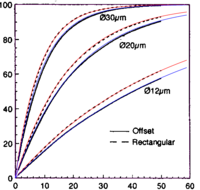This article may be confusing or unclear to readers.(September 2007) |
Filling factor, is a quantity measuring the efficiency of absorption of pump in the core of a double-clad fiber. [1] [2] [3]
This article may be confusing or unclear to readers.(September 2007) |
Filling factor, is a quantity measuring the efficiency of absorption of pump in the core of a double-clad fiber. [1] [2] [3]

The efficiency of absorption of pumping energy in the fiber is an important parameter of a double-clad fiber laser. In many cases this efficiency can be approximated with [4]
where
The filling factor may depend on the initial distribution of the pump light, the shape of the cladding, and the position of the core within it.
The large (close to unity) filling factor is important in double-clad amplifiers; it allows them to reduce the requirements for the brightness of the pump and to reduce the length of the fiber laser. Such a reduction is especially important for the power scaling of various nonlinear processes, and contributions of stimulated scattering to the degradation of signal. Use of the filling factor for the estimate of the efficiency of absorption of the pump in fiber lasers allows quick estimates without performing complicated numerical simulations.